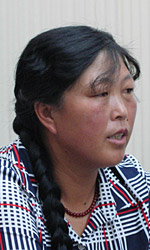| Twenty-two years ago, 20-year-old Yin Yuzhen was sent by her father from Shaanxi Province to Inner Mongolia to marry a young man in the village of Wushen Banner (county) in Ordos City. At the time it was called Yikezhao League (prefecture). Near her house, there was nothing but sand. Loving green ever since childhood, Yin began to plant trees and flowers near her house the very next month. She knew trees could absorb the dazzling sunlight reflected by sand and bring shade to her family.

In the early days, since Yin didn't know the proper techniques, less than 50 percent of the trees she planted survived. The trees were often covered by drifting sand dunes or overturned by sand storms. Through trial and error, Yin found out suitable trees and the proper locations to plant them. At present, Yin, managing nearly 4,500 hectares of forest, feels that the microclimate has greatly improved. In the past, when she woke up every morning, sand would get into her eyes, nose and mouth. Now, only a little sand is left on the windowsill. Her example has spurred more than 100 local households to plant trees, each of them now has around 1,000-2,000 hectares of forest.
Because of the poor transportation in her village, Yin cannot sell the products from her trees. She has to live on the 300 sheep and 40 cows she feeds. But Yin feels no regrets even if her son didn't pass this year's college entrance examination. She has little time to take good care of her son. "I plant trees not merely for myself, but for the future generations," Yin told Beijing Review.
Fighting back the desert
Long ago, Inner Mongolia used to be a place with dense forests and lush grasslands. However, because of the increasing population of local residents and livestock, as well as natural disasters, its ecological environment became severely damaged.
In west Inner Mongolia, there is a desert called Wulanbuhe, stretching over Alashan League, Wuhai City and Bayannaoer City and covering about 14,000 sq km along the Yellow River. "Although it is not the largest desert in Inner Mongolia, its influence is the largest, since it is in an area with high population density," Li Shuping, an official from the Department of Forestry of the Inner Mongolian Autonomous Region, told Beijing Review.
According to Li, various measures have been adopted to improve the ecological environment. Sand barriers were erected first to fix the drifting sand, and then shrubs, trees and grass suitable for the desert were planted, such as sea buckthorn, caragana and salix. These plants not only help fix sand, but also bring economic benefits to local farmers. Fruit from the sea buckthorn can be made into beverage, vinegar and so on. Salix, a variety of willow, must be cut down every three or four years in order to promote its growth, while the cut salix can be made into paper and synthetic boards. On average, every hectare of sand can produce 100,000-120,000 kg of salix and every kg of salix can be sold at 0.6 yuan. Moreover, aerial sowing has been introduced to raise the efficiency of forestation.
Now, there is a complete forest belt at the edge of the Wulanbuhe Desert along the Yellow River. The edge of the desert has shrunk 10 km inward and the sand it brings to the Yellow River has been reduced year by year, said Li.
According to the third national desertification and sandy land monitoring carried out by the State Forestry Administration in 2004, desertified land in Inner Mongolia was 62.2 million hectares, 1.6 million hectares less than that in 1999, while sandy land was 41.6 million hectares, 487,000 hectares less than the figure in 1999.
Restoring grassland
Namuhai, of the Mongolian ethnic group, is a villager in Aolike Gacha (village) of Sanggendalai Town in Xilinguole League. With 115 households, this is the first gacha that has fully migrated from the pasture area in Inner Mongolia. From 1999 to 2001, Xilinguole was hit by severe drought. Worsened by years of overgrazing, 70 percent of Namuuhai's grassland became sandy and deteriorated, and the per-capita annual income of his family was less than 500 yuan.
|
